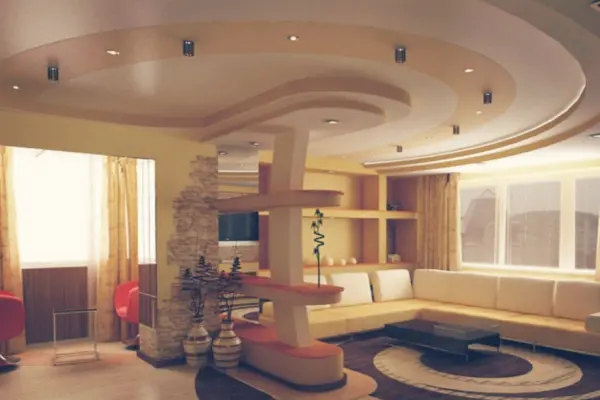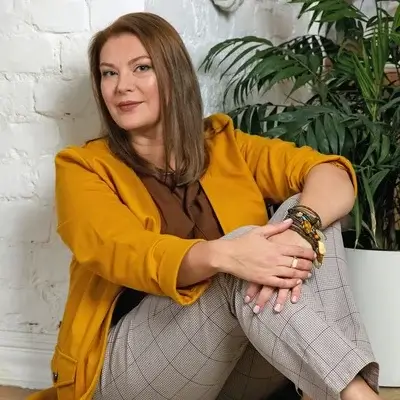Multi-level stretch ceilings have gained wide popularity in interior design due to their unique advantages. While drywall was predominantly used for creating multi-level ceiling structures in the past, today multi-level stretch ceilings have taken first place, offering more possibilities for design and space zoning.
Two-level stretch ceilings with lighting become a true decoration of modern apartments and houses, visually enlarging the space and adding elegance to the interior. Isn't it amazing how properly selected multi-tier ceiling design can completely transform your home? Let's explore what other benefits multi-tier ceilings have and why you should consider installing multi-level stretch ceilings in your home.
Key Benefits of Multi-Tier Ceilings
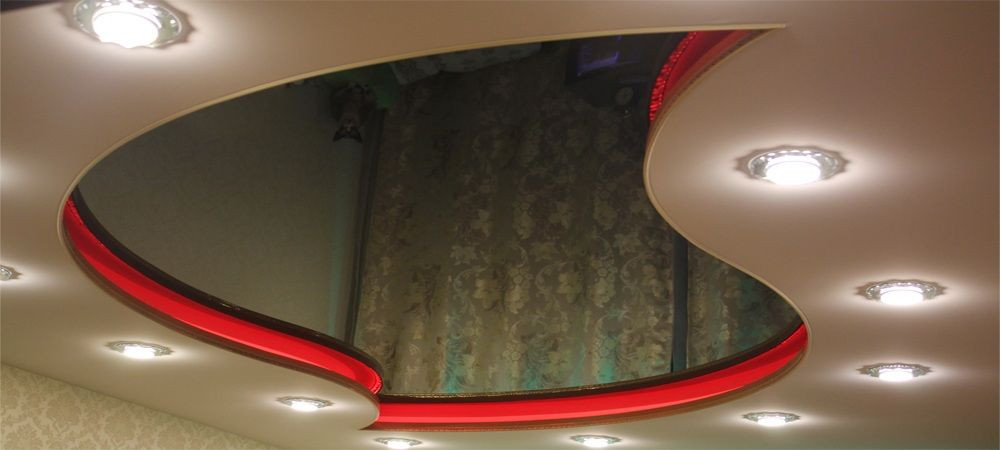 The main advantage of multi-tier ceilings is their aesthetic appeal and design possibilities. Multi-level stretch ceilings in interiors create a unique atmosphere suitable for both home spaces and commercial premises. You'll be pleasantly surprised at how the benefits of multi-tier ceilings can exceed your expectations!
The main advantage of multi-tier ceilings is their aesthetic appeal and design possibilities. Multi-level stretch ceilings in interiors create a unique atmosphere suitable for both home spaces and commercial premises. You'll be pleasantly surprised at how the benefits of multi-tier ceilings can exceed your expectations!
"Multi-level stretch ceilings are not just a decorative element, but a multifunctional system capable of solving a whole range of interior tasks simultaneously: from zoning to acoustic comfort, from hiding communications to creating effective lighting. That's why they are so in demand among modern designers."
Multi-tier stretch ceilings are ideal for zoning spaces using ceilings, especially in studio apartments. Multi-level ceilings with niches help visually divide the room into functional zones without the need to build walls or partitions. Additionally, they allow you to hide construction flaws, such as irregularities, visible wires, and pipes – hiding communications under the ceiling has become much easier with the use of multi-level structures.
These ceilings are a real find for designers, as they provide an opportunity to radically change the appearance of a room, emphasizing its advantages. Professionals can implement the boldest ideas, combining different types of stretch ceilings, choosing unique color solutions for tiered ceilings and original lighting options for multi-tier ceilings. Have you ever wondered how multi-tier ceilings in a small room can make the space visually larger?
Features of Two-Level Stretch Ceilings
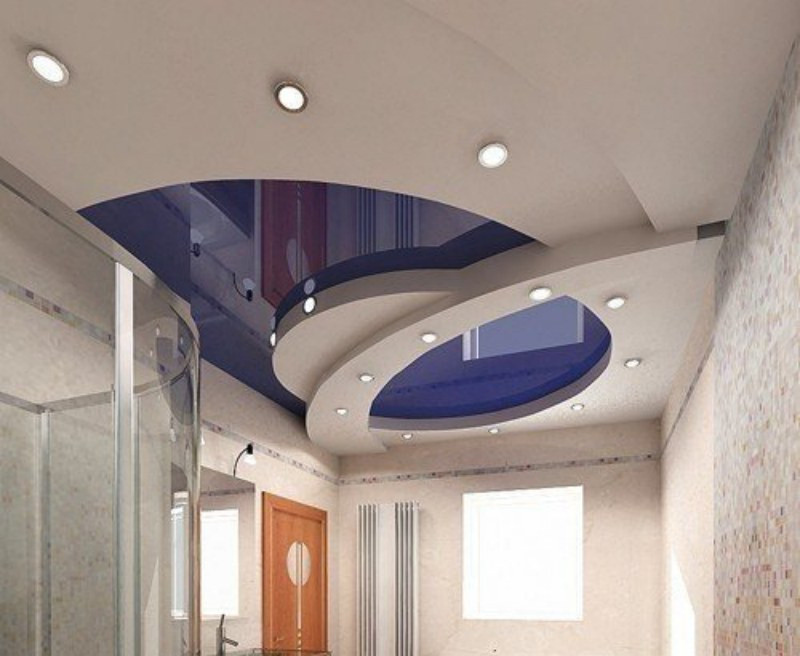 The most popular option is a two-level stretch ceiling, which combines all the advantages of multi-level and single-level ceilings. Installing two-level ceilings allows you to hide minor repair defects and engineering communications, protecting the room from possible leaks from above. More than 65% of apartment owners note that installing multi-tier ceilings helped solve the problem of hiding irregularities in the base ceiling.
The most popular option is a two-level stretch ceiling, which combines all the advantages of multi-level and single-level ceilings. Installing two-level ceilings allows you to hide minor repair defects and engineering communications, protecting the room from possible leaks from above. More than 65% of apartment owners note that installing multi-tier ceilings helped solve the problem of hiding irregularities in the base ceiling.
A two-level ceiling contributes to the visual enlargement of the room's space and makes it brighter and cozier, especially when using glossy or mirror coatings on the second level. Floating multi-level ceilings with LED lighting create the impression that the upper level seems to float in the air, visually raising the ceiling. Imagine how your room will be transformed with LED-lit ceilings!
Such ceilings are suitable for any room, but multi-tier PVC ceilings look especially impressive in spacious halls, adding majesty and luxury. Three-level stretch ceilings create an even more impressive effect but require sufficient room height. Did you know that combined ceilings for kitchens can not only decorate the space but also make it more functional?
| Characteristic | Single-Level Stretch Ceilings | Multi-Level Stretch Ceilings |
|---|---|---|
| Installation time | 2-4 hours | 1-2 days |
| Zoning possibilities | Limited | Extensive |
| Hiding defects and communications | Basic | Advanced |
| Visual space enlargement | Moderate | Significant |
| Lighting options | Standard | Extended (niches, floating lines) |
| Acoustic properties | Basic | Improved |
| Cost per m² | $15-30 | $30-80 |
Before choosing the type of ceiling for your space, it's worth carefully studying the characteristics presented in the table. This table clearly demonstrates the differences between single-level and multi-tier stretch ceilings according to key parameters. As you can see, multi-level structures, despite their higher cost, offer significantly more possibilities for the design and functionality of the space.
Technical Characteristics and Materials of Stretch Ceilings
 Multi-level stretch ceilings are made predominantly from two types of materials: PVC (polyvinyl chloride) and fabric. Materials for stretch ceilings are constantly being improved, allowing for the creation of increasingly complex and interesting structures. The performance characteristics of ceilings depend on the quality of the chosen materials, so their selection should be approached responsibly.
Multi-level stretch ceilings are made predominantly from two types of materials: PVC (polyvinyl chloride) and fabric. Materials for stretch ceilings are constantly being improved, allowing for the creation of increasingly complex and interesting structures. The performance characteristics of ceilings depend on the quality of the chosen materials, so their selection should be approached responsibly.
PVC canvases are characterized by moisture resistance, durability, and lightness, available in glossy, matte, and satin variants with various colors and texture combinations in ceilings. The combination of PVC and drywall in multi-level structures allows for achieving unique visual effects. Incredibly, stretch ceilings with photo printing can create an atmosphere of starry sky, tropical forest, or any other landscape in your room!
"When choosing a material for a multi-tier ceiling, pay attention not only to color and texture but also to its performance characteristics. For rooms with high humidity, such as bathrooms or pools, PVC canvases with anti-fungal impregnation will be the optimal option. For bedrooms and children's rooms, I recommend choosing eco-friendly fabric ceilings that 'breathe' and do not emit harmful substances even when heated."
Fabric ceilings, made of polyester with polyurethane coating, stand out for their environmental friendliness and sound insulation properties. The acoustic properties of ceilings are especially important in rooms where a lot of time is spent or where good sound insulation is required. Ceiling design in 2025 increasingly includes elements with improved acoustic characteristics.
These ceilings are distinguished by their moisture resistance, especially PVC, which effectively protects against flooding. Both types of materials are noted for their durability, with the service life of multi-level ceilings potentially exceeding 15 years with proper maintenance, and they are treated with fire-retardant additives to increase fire safety. They also adapt well to different temperature conditions. Isn't it impressive how modern technologies allow for the creation of such durable and functional structures?
Installation and Maintenance of Multi-Tier Stretch Ceilings
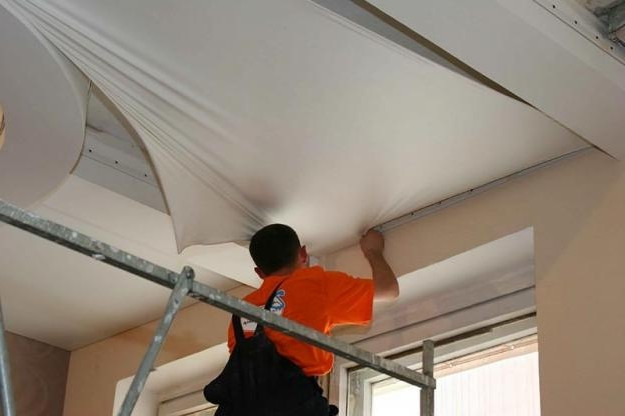 The process of installing multi-tier stretch ceilings begins with thorough preparation of the base, which includes leveling and cleaning the surface from dust and dirt. Then, a frame made from metal or aluminum profiles is installed, onto which the canvas is stretched. The shapes and profiles of multi-tier ceilings can be very diverse – from simple geometric to complex curvilinear. Interestingly, ceilings with 3D effects require special installation techniques and special materials.
The process of installing multi-tier stretch ceilings begins with thorough preparation of the base, which includes leveling and cleaning the surface from dust and dirt. Then, a frame made from metal or aluminum profiles is installed, onto which the canvas is stretched. The shapes and profiles of multi-tier ceilings can be very diverse – from simple geometric to complex curvilinear. Interestingly, ceilings with 3D effects require special installation techniques and special materials.
In the case of PVC canvases, a special heat gun is used for stretching and fixing them. Installing multi-tier ceilings is work for professionals, so you shouldn't try to do it yourself. The cost of multi-tier ceilings with installation depends on the complexity of the structure and the materials used. When is the best time to install a multi-level ceiling? The optimal time is the final stage of renovation when the walls are already finished, but large furniture has not yet been installed.
Maintaining stretch ceilings is not complicated – they only require regular wiping with a damp cloth. How do you care for multi-tier ceilings? It's enough to periodically clean them from dust using a soft cloth or special products for stretch ceilings. If damaged PVC canvases need repair, they can be replaced without dismantling the entire structure. Restoration of stretch ceilings may be necessary in case of serious damage, but such situations are quite rare.
Client Story: Living Room Transformation with a Multi-Level Ceiling
The Romanov family from Kyiv decided to update their living room, which seemed cramped due to low ceilings (2.5 meters). The designer suggested installing a two-level stretch ceiling with perimeter lighting and a combination of glossy white and matte blue canvases.
"We doubted that such a complex structure would be suitable for our small living room," says Elena Romanova. "But the result exceeded all expectations! The room visually became at least half a meter higher, and the built-in LED lighting created an incredibly cozy atmosphere. The installation took only a day and a half, without dust and dirt. It's been three years now, and the ceiling looks like new, despite the fact that we've had problems with upstairs neighbors twice. The water simply collected in the canvas, which professionals then carefully drained and restored the ceiling's shape. I sincerely recommend it to everyone who wants to transform their home!"
Design Recommendations
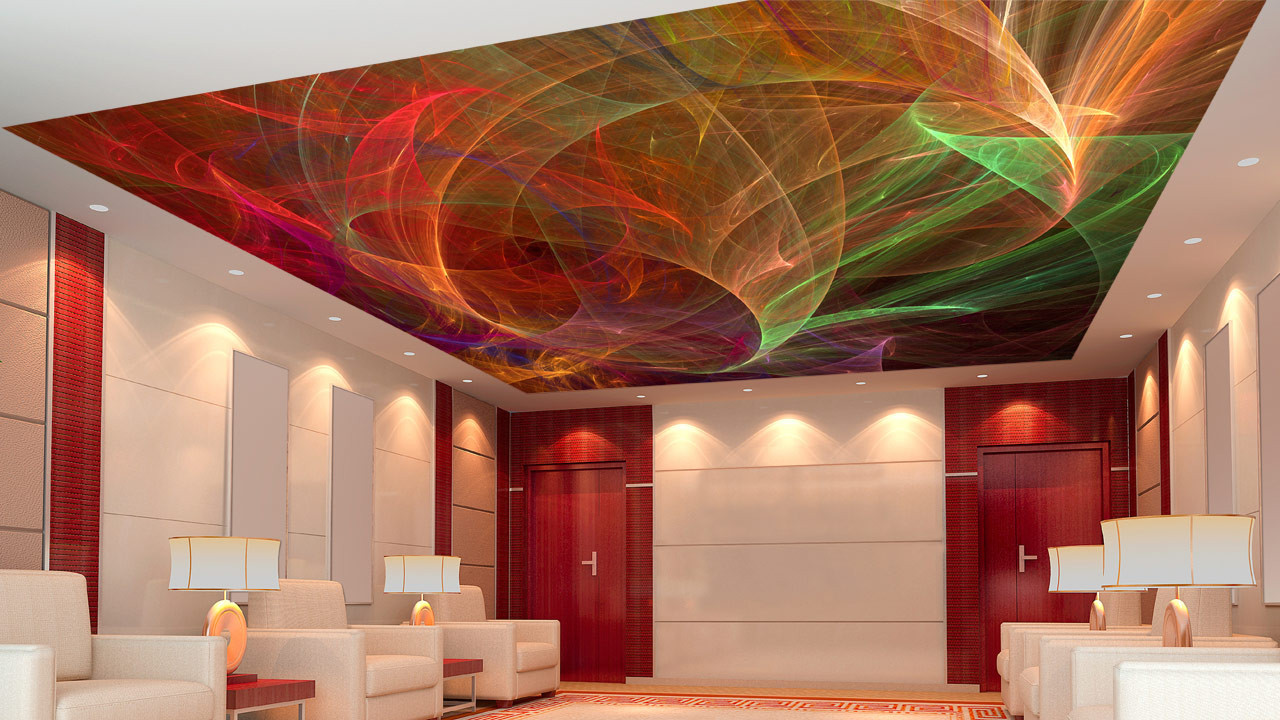 Multi-level ceilings open up wide possibilities for combining different styles in the interior. The design of multi-tier ceilings can be executed in any style – from classic to ultra-modern. Color solutions for tiered ceilings are limited only by your imagination – you can choose both neutral and bright, contrasting colors. Interiors with tiered ceilings always look stylish and modern.
Multi-level ceilings open up wide possibilities for combining different styles in the interior. The design of multi-tier ceilings can be executed in any style – from classic to ultra-modern. Color solutions for tiered ceilings are limited only by your imagination – you can choose both neutral and bright, contrasting colors. Interiors with tiered ceilings always look stylish and modern.
They allow for the harmonious integration of classic and modern elements, such as traditional cornices with modern lighting. The use of color and light plays an important role: you can experiment with different color solutions at different ceiling levels and create unique visual effects using hidden lighting or LED strips. Are there myths about stretch ceilings? Certainly, and one of them is that they emit harmful substances, although modern certified materials are absolutely safe.
"When designing a multi-level ceiling in a room with low walls, prefer light tones and mirror surfaces. This will help visually 'raise' the ceiling. For large spaces, you can use bolder solutions – dark colors, contrasting combinations, or even stretch ceilings with photo printing. Don't forget about proper lighting – it is light that can turn an ordinary ceiling into a work of art."
Multi-tier ceilings are ideal for zoning space, especially in large rooms, allowing them to be visually divided into different zones. Decorative ceiling structures can become the main accent in the interior, giving it individuality and character. Isn't it amazing how a properly selected ceiling shape can completely change the perception of space?
In rooms where special attention to acoustics is required, such as cinemas or music studios, fabric multi-level ceilings can be the optimal solution for improving sound characteristics. Stretch ceilings with 3D effects create an impression of volume and depth, which looks especially effective in modern interiors.
Interiors with tiered ceilings always look more expensive and prestigious, even if the rest of the finish is done in a restrained style. Designer stretch ceilings can become a real highlight of your home, attracting the attention of guests and creating a special atmosphere.
Conclusion
Multi-tier stretch ceilings represent a universal solution for modern interiors, combining aesthetic and practical advantages. Their installation can radically transform any room, from a modest apartment to a luxurious mansion. When choosing multi-level stretch ceilings, it's important to consult professionals who will help correctly design the structure, select materials, and perform impeccable installation.
If you're thinking about renovating or updating the design of your home, be sure to consider the possibility of installing multi-tier stretch ceilings – it's an investment that will not only increase the value of your property but also create a unique atmosphere of comfort and beauty for many years. Isn't it worth giving yourself and your loved ones such a transformation of space?
